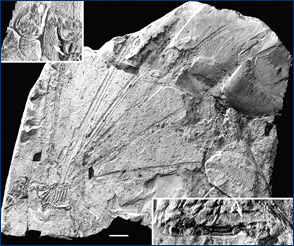
Prolacertiformes
Long-necked, lizard-like reptiles, drepanosaurs, and Longisquama
Prolacertiforms — literally, "before lizard forms" — are a group of superficially lizard-like diapsids from the late Permian and the Triassic. Typical early forms include Protorosaurus, from the late Permian of Europe, and Prolacerta, from the Lower Triassic of South Africa. These two genera were very much alike. Both were one to two meters long and looked like large, long-necked lizards. In overall appearance, they were very similar to living monitor lizards, and they were probably similar ecologically. From their teeth, all prolacertiforms seem to have fed on insects and small vertebrates. Some taxa were aquatic and ate fish and small invertebrates.
Except for the drepanosaurs and Longisquama, all of the known prolacertiforms are relatively long-necked, and some had incredibly long necks, like Tanystropheus (from Germany, Switzerland, and Israel) and Dinocephalosaurus (from China). The largest species of Tanystropheus were up to six meters long (about 20 feet), but more than half of that length was neck, while the body measured less than a meter! Dinocephalosaurus also had a very long neck, up to twice the length of the body. However, cladistic analysis shows that although Tanystropheus and Dinocephalosaurus are both prolacertiforms, they are not particularly closely related, and each genus seems to have evolved its long neck independently. Convergent evolution of the long necks is also supported by their structure. The neck of Tanystropheus includes 12 vertebrae, but the individual vertebrae are very long. Dinocephalosaurus has more than twice as many neck vertebrae (25), and the individual vertebrae are a lot shorter. The hands and feet of Dinocephalosaurus are paddle-like, and it probably used its long neck to strike at fish.
 Restoration of the long-necked Tanystropheus. |
The habits of Tanystropheus are less well understood. The small number of long, rod-like vertebrae would have limited the flexibility of the neck, and the hands and feet do not appear to be well adapted for swimming (although this is still debated). If Tanystropheus was a swimmer, it is hard to see how its long neck would have helped it feed. Alternatively, some paleontologists have suggested that Tanystropheus rested on land, near the water's edge and used its long neck to dip fish out of the water. But it is not clear how such a small animal could have lifted such a long neck. Although we may not know for certain how Tanystropheus was catching aquatic animals, it is clear that it caught them: some specimens have been found with fish bones and parts of cephalopods (squid relatives) in their stomachs.
Drepanosaurs
The drepanosaurs are interesting enough to merit their own page — see Drepanosauromorpha, the "monkey lizards".
 This is the only specimen of Longisquama insignis that preserves both a portion of the body fossil (the rear half of the animal is missing) with its long scales. The specimen is from Late Triassic lake deposits, Kyrgyzstan. |
The center of the attention and the controversy is the double row of long scales sticking up from the back and shoulders of the specimen. In fact, Longisquama means "long scale." At one time or another, these have been interpreted as parachutes, membranes for gliding, and primitive feathers. New studies show that they are not feathers, but rather are unusual, hollow scales. From the single available specimen, it is not clear if they folded down to the sides, to the back, or not at all. In the Disney movie Dinosaur (1999), a Longisquama is shown flapping its scales to achieve powered flight. Needless to say, this fanciful scenario goes far beyond anything that can be determined from the fossil. (NOTE: It also shows Longisquama with Cretaceous dinosaurs that lived 150 million years after the Triassic.)
The skull of Longisquama has a hole in front of the eye socket and another in the lower jaw. These have been interpreted as an antorbital fenestra and a mandibular fenestra, which are characters of archosaurs. However, these features are extremely small, only a couple millimeters across, and it is possible that they actually represent areas of broken bone. Also, the front of the snout is broken off, and the hole in front of the eye could possibly be the nostril. Other features of the jaw and shoulder girdle suggest a relationship to lepidosaurs, the group that includes Sphenodon, lizards, and snakes. It is unlikely that the controversy surrounding Longisquama will come to an end until new fossils are discovered. For now, we'll place it in Prolacertiformes.
Longisquama and the drepanosaurs were all small animals that probably lived in trees and ate insects.
For more information on Longisquama, see the Wikipedia entry.
Prolacertiforms are known from every continent except South America and Australia.
Sources
|
||
Text by Matt Wedel, 5/2007. Tanystropheus illustration courtesy of Silvio Renesto, University of Insubria, Italy; Longisquama image from Jones, T.D, J.A. Ruben, L.D. Martin, E.N. Kurochkin, A. Feduccia, P.F.A. Maderson, W.J. Hillenius, N.R. Geist, and V. Alifanov. 2000. Nonavian feathers in a Late Triassic archosaur. Science 288(5474):2202-2205 — reprinted with permission of AAAS